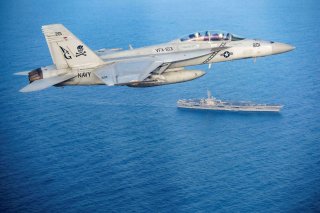Why the Navy's F/A-XX Won't Push the F/A-18 into Retirement
Navy Aviation Vision 2030-2035 explains how the F/A-18, F-35B, and F/A-XX will all play a role in carrier air wings of the future.
The U.S. Navy is laying the groundwork for its newest fighter, but it won’t get rid of the F/A-18 Super Hornet anytime soon.
Navy Aviation Vision 2030-2035, published in late October, explains how the Navy's older airframes will fly with state-of-the-art platforms.
A single image of a proposed F/A-XX in the Navy publication shows what the new fighter could look like in general terms. Unfortunately, the two-dimensional rendering doesn’t reveal much, though the Navy explained that the fighter would act as a “quarterback,” able to command and control unmanned and attritable air assets.
Though information on the new F/A-XX is undoubtedly one of the most significant aspects of Navy Aviation Vision 2030-2035, the teaming between the new fighter and one of the Navy’s oldest carrier fighters is also intriguing.
F/A-18 Super Hornets
Despite their status as the Navy’s oldest fighters, the F/A-18 Super Hornets still have a role to play in carrier air wings. Though the F/A-XX will undoubtedly be considerably stealthier than its F-35 predecessor, the new airplane will not simply replace that airframe, nor will it force the venerable Super Hornet variants into retirement.
On the contrary, the Navy’s future carrier air wings will feature a mix of airframes, including the new F/A-XX, the F-35 Lightning II, as well as the F/A-18E/F Block III. Rather than flying off into the sunset, the newest Block III Super Hornets will form “the backbone of the CVW through 2035.”
Compared to its predecessors, the Block III Super Hornets will have improved computing capabilities, a reduced radar signature thanks to radar-absorbent coatings, larger multi-function displays, an improved Infrared Search and Track (IRST) package, and satellite communication system. The Navy has also toyed with the idea of outfitting Super Hornets with conformal fuel tanks to expand their range. However, it is unclear if those fuel tanks can withstand the rigors of carrier operations, and the Navy may not integrate them into Block III Super Hornets.
Furthermore, F-35s and F/A-18 will work together, allowing the older fighter design “to be a more survivable and lethal platform [by] leveraging the F-35C’s stealth and passive detection abilities to shape the overall air picture.”
Still, by 2035 the Navy’s Super Hornet will be a 34-year-old design despite steady improvements. Once retired, “a combination of F-35C and F/A-XX will provide Navy tactical fighter aircraft capability and capacity within the CVW. The advanced carrier-based power projection capabilities resident in F/A-XX will maintain CVN [Carrier Air Wing] relevance in advanced threat environments.”
Thanks to a slew of upgrades, the Navy has managed to keep the original Hornet combat-effective, albeit in a significantly upgraded Super Hornet form. Thanks in part to up-to-date computing power and advanced stealth coatings, it looks like the Navy’s Super Hornets will continue to fly for at least another 15 years.
Caleb Larson is a multimedia journalist and Defense Writer with the National Interest. He lives in Berlin and covers the intersection of conflict, security, and technology, focusing on American foreign policy, European security, and German society.
Image: Reuters

